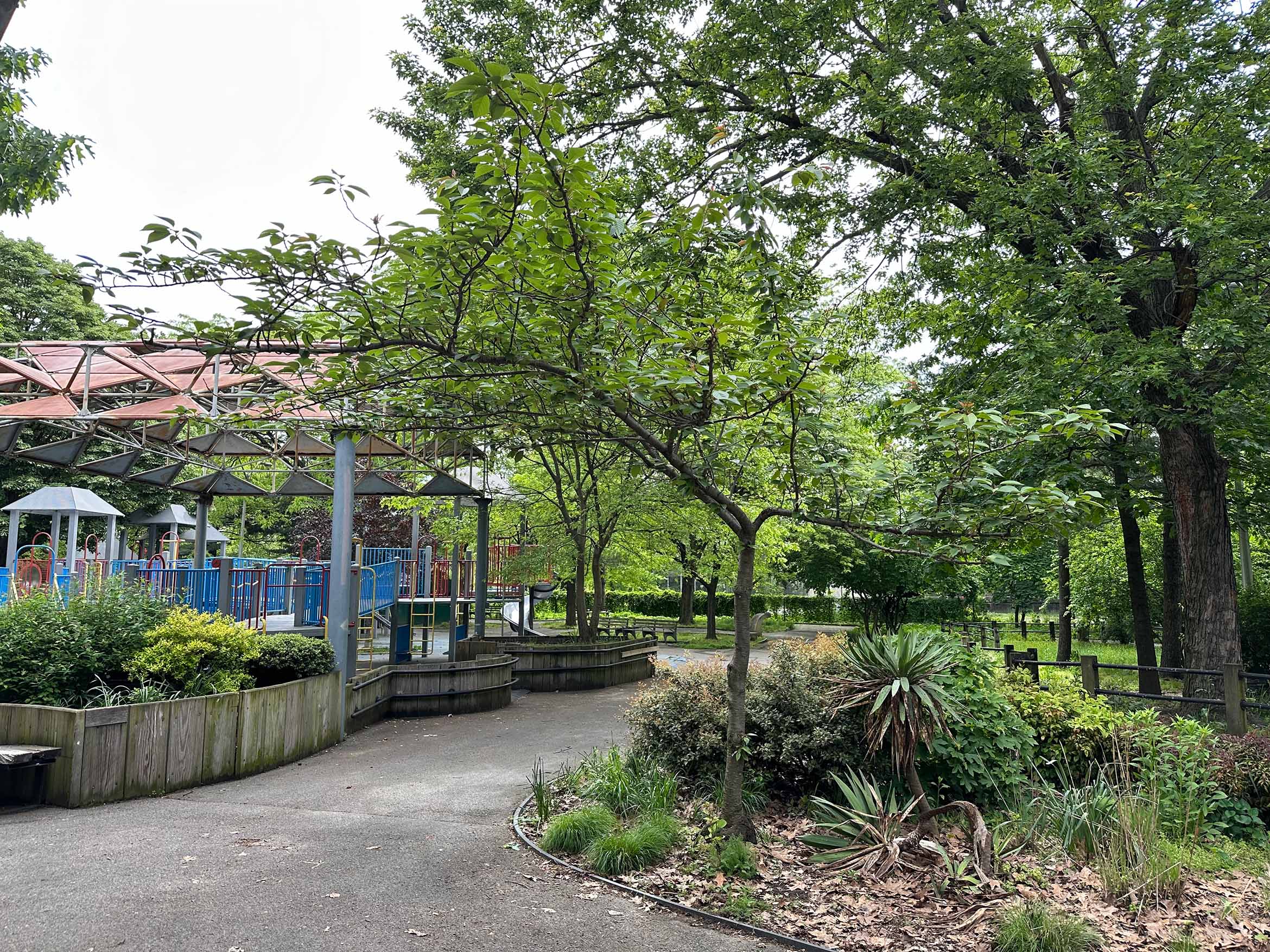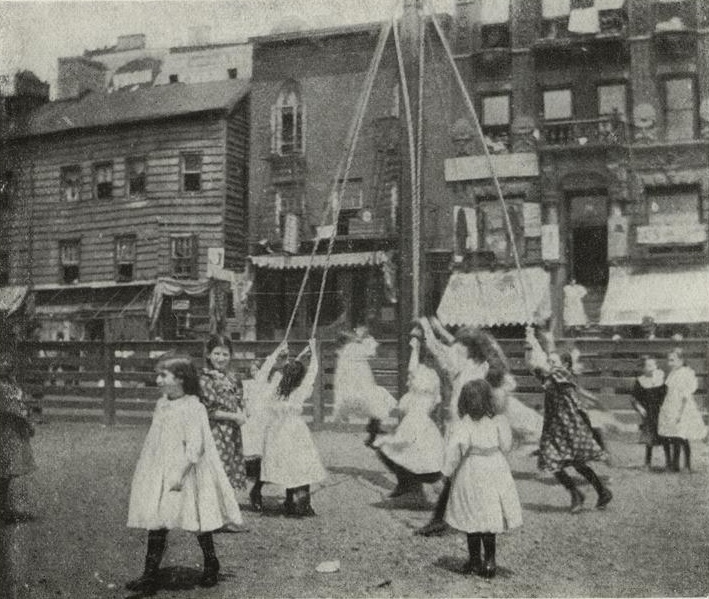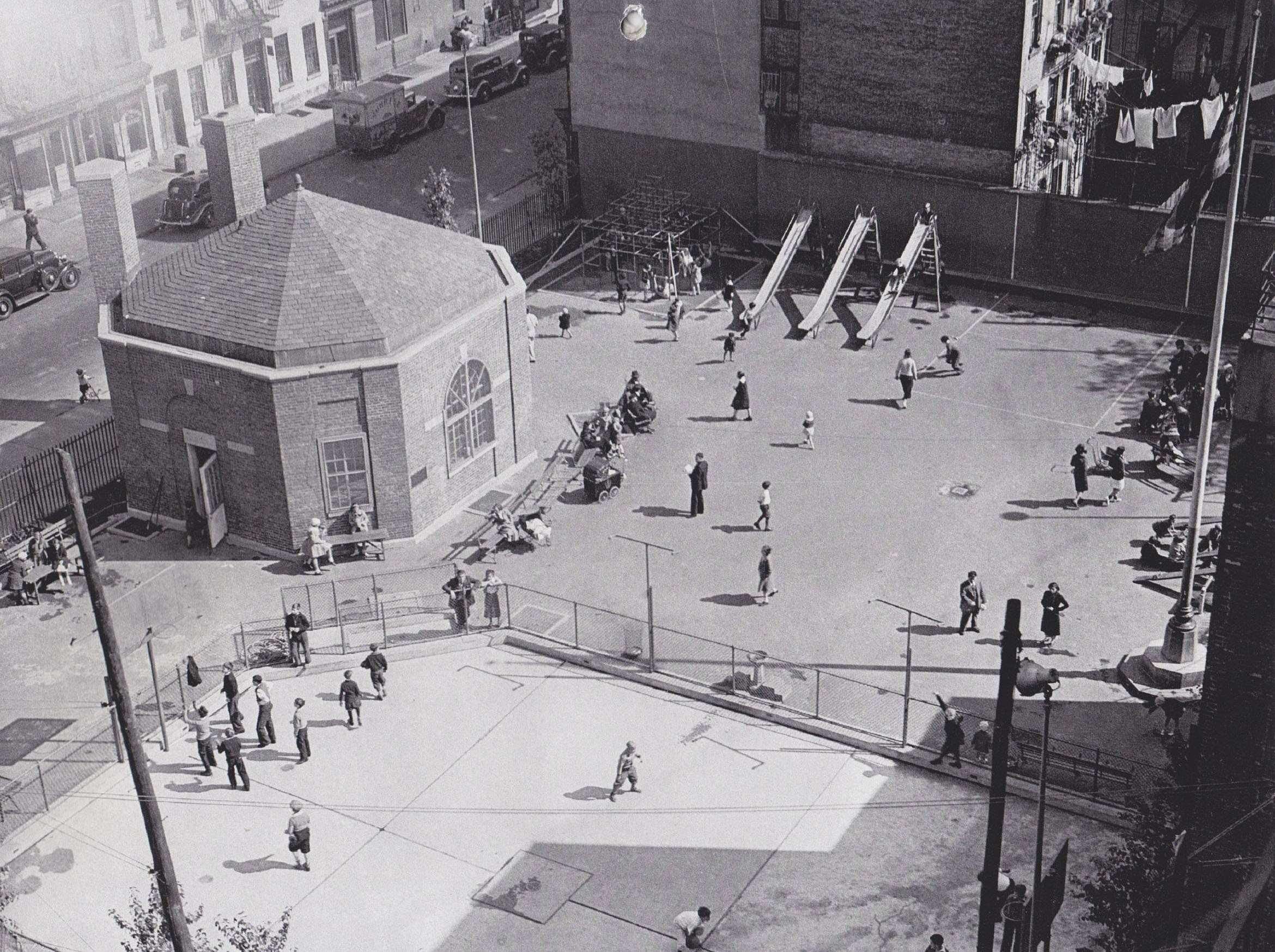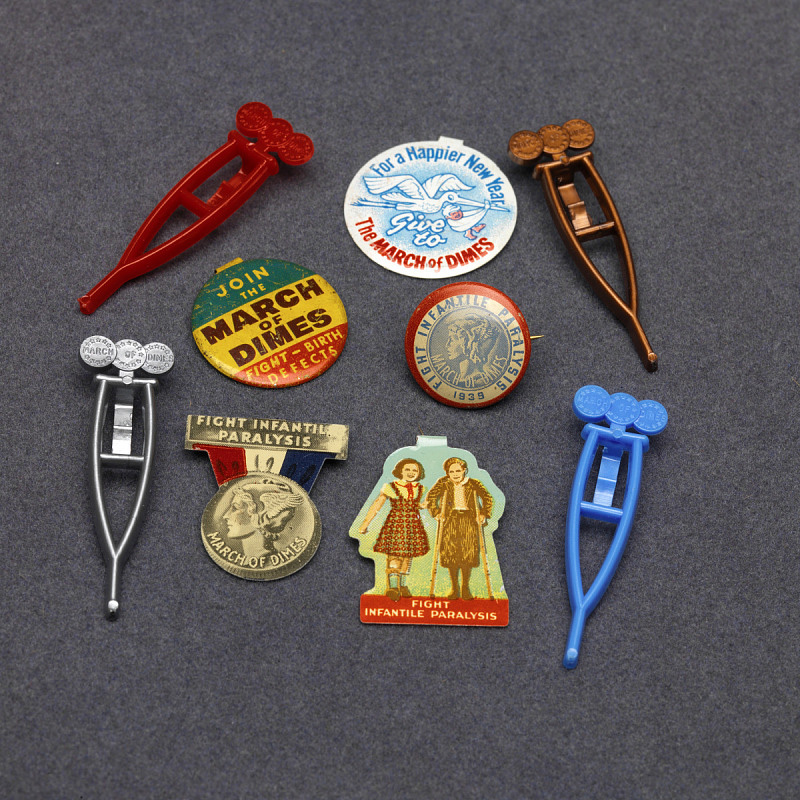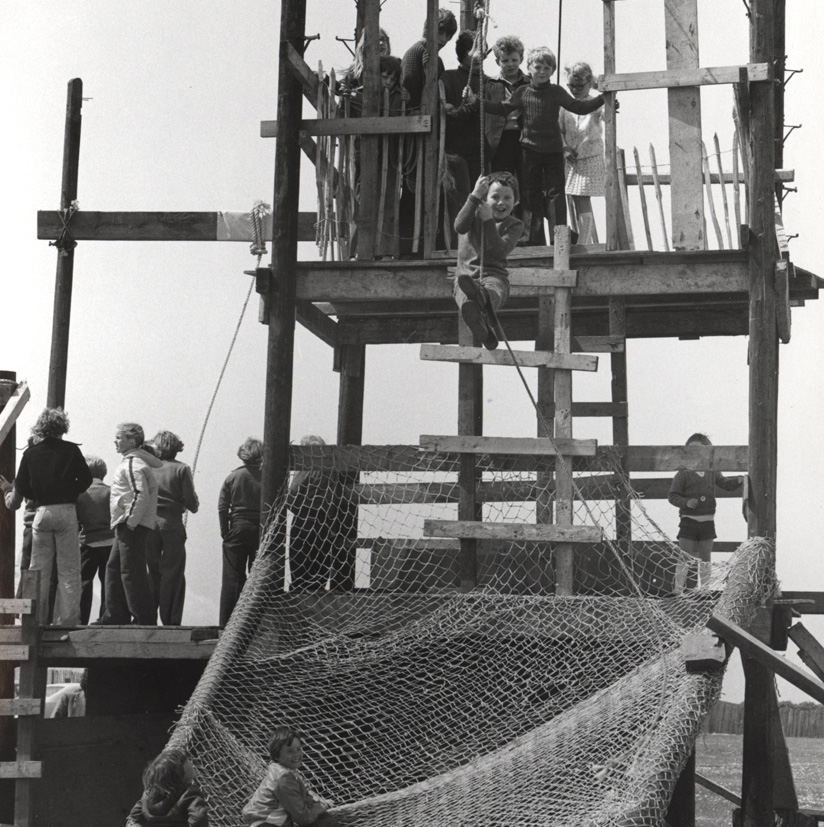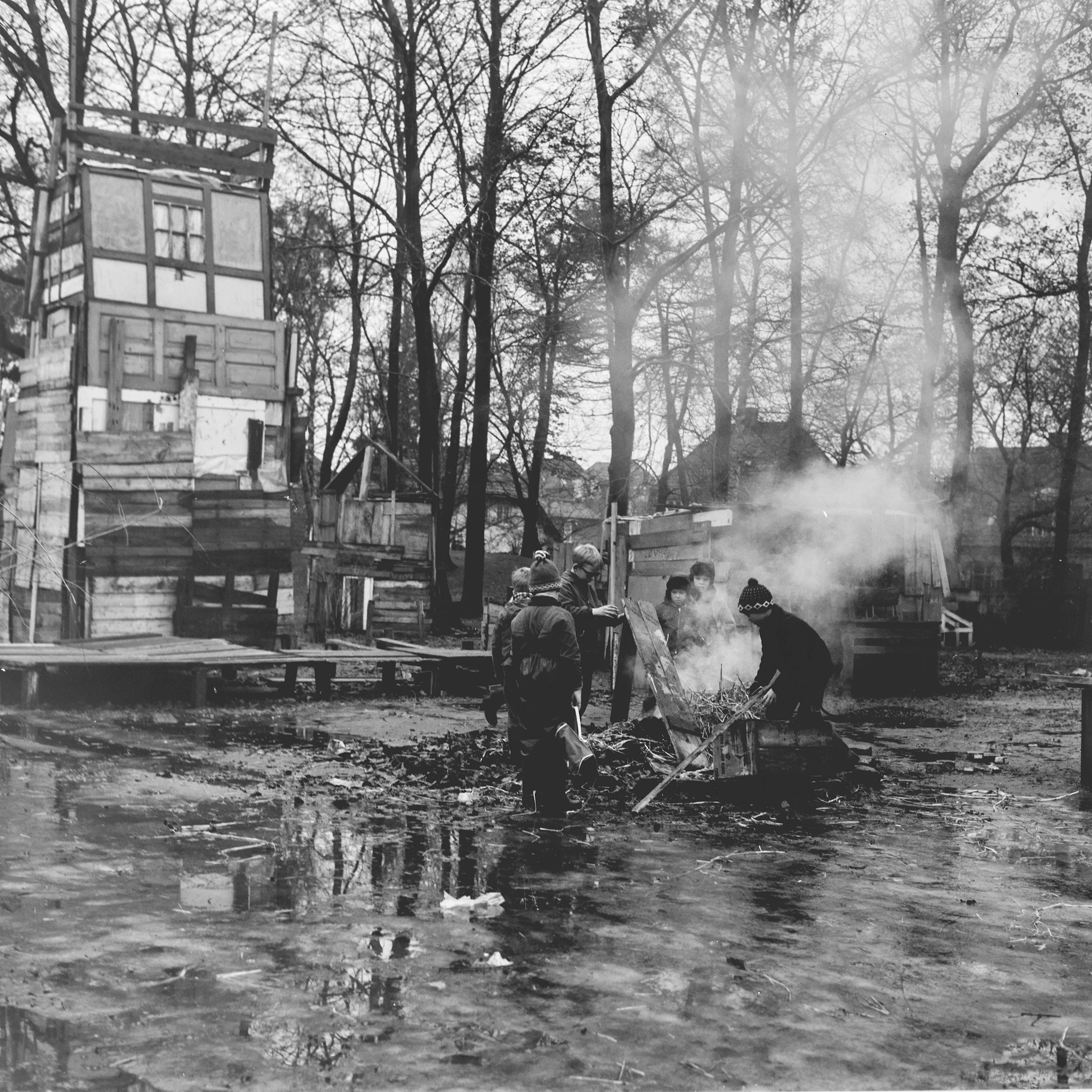
We are celebrating 15 years — and counting — of stories that are deeply researched and deeply felt, that build a historical record of what the city has been.
We are celebrating 15 years — and counting — of stories that are deeply researched and deeply felt, that build a historical record of what the city has been.
For kids, the playground is a rare zone of feral freedom, magic, and fun. Any adult who’s spent time in one can also attest to its condition as microcosm of our social relations: petty slights, greed, deferred maintenance, to name a few. Historians can detail how the playground has long sought to mold children as subjects of planners’ ideal society. It’s also the rare noncommercial public space where families feel safe, if not too safe, protected by a fence and with padded flooring and super-vetted equipment warding off any possibility of lawsuits or lurkers.
Today’s average American playground represents a certain lack of imagination. But forty years ago, city planners, architects, and others in New York City took a bolder approach, designing a challenging, embracing “Playground for All,” where disabled and non-disabled children could play side by side. Rejecting segregated facilities and limited opportunities for children with physical or developmental disabilities, such a playground was to model a more inclusive city. In 2024, this original Queens Playground for All Children still stands, slightly modified, and other playgrounds across the city offer varying levels of accessible features. But inclusive play remains very much a work in progress, one that’s long seemed stalled. Irina Verona and Jennifer Carpenter, who as designers are deeply engaged in creating environments for neurodivergent youth, here revisit the ways we have — and we might — approach children’s development, belonging, and free play.
In the early 1970s, New York City embarked on an ambitious project to change the state of play for children across the country. The Playground for All Children was a proposal rooted in the conviction that playgrounds should be places for able-bodied and disabled children to play together. The opening of the first Playground for All Children in Flushing, Queens in 1984 was the culmination of a decade-long planning and design process which is difficult to imagine today, bringing together federal and city agencies, disabled children, families, and advocates, public officials and administrators, and dozens of designers, planners and students.
New York City’s Department of City Planning launched a Special Projects Unit to improve the urban environment for disabled people in September 1974. The planners recognized that the City’s playgrounds did not accommodate disabled children, and that the public was not thinking about disabled children’s play. A nationwide research and audit phase was followed by a design competition, and the entire process was documented in a 1978 resource book published with the express goal of allowing other municipalities to learn from this work. The introduction reads:
When someone says the word ‘playground,’ what comes to mind? Chances are that a busy, noisy place is visualized . . . Chances also are that the children who come to mind are active, able-bodied youngsters. The child who has cerebral palsy, the child who is retarded, the child in a wheelchair, or with braces and a cane — where are they in this imaginary tableau? Probably these children just don’t come to mind at all. Most people simply do not think of children who are handicapped when they think of playgrounds.
It was a step toward a more inclusive future where a wide range of bodies and minds could find joy together, a future that the authors noted is “not simply a matter of removal of barriers, or design of special components” but is instead an “altogether different approach to the idea of what a playground should be.” For the first time, physically and cognitively disabled kids would be accommodated not in separate playgrounds or facilities but alongside their non-disabled peers in truly public spaces — a radical change from years of invisibility and segregation. Disability was to be an essential part of both the playground design and the design process itself.
Forty years later, the city has greatly expanded the number of playgrounds with accessible features and introduced components such as sensory domes, and even sensory gardens, meant to be more neuroinclusive. These newer play spaces — which must answer to accessibility laws and codes, and to new safety and testing requirements — typically offer equipment-based solutions for disability, in the form of special swings, ramped components, and other designated accessible features. But none of these playgrounds, including the five Playgrounds for All Children built between 1997 and 2007, have as broad an ambition or as compelling a vision of inclusion as the 1984 prototype. Why did the promise of the first Playground for All Children never materialize? Why aren’t all playgrounds for all children? What can we learn from this unique experiment today?
The first American urban playgrounds emerged from ideas about children’s health, education, and urban reform that, as Susan Solomon notes in her book American Playgrounds, were often overlapping: “crime prevention, character building, and just plain exercise.” From their first appearance at the turn of the 20th century, these playgrounds were part of a complex ecosystem that emerged to protect the wellbeing of children in the growing cities. Providing a safe alternative to the dangers of the streets, these places were part of a wider calculation of societal costs summed up in the 1902 slogan by Joseph Lee, an activist, philanthropist and playground advocate: “The boy without a playground is father to the man without a job.”
The first municipal playground in the country was built in 1903 in Seward Park, on New York’s Lower East Side. The Playground Association of America was founded in 1906, formalizing the playground movement. Playgrounds began to proliferate on empty lots and street corners and in parks across the country’s urban areas. Central Park saw its first playground in 1926.
Early playgrounds were demarcated by fences and populated with swings, sandboxes, and seesaws. They also contained spaces for group activities that were conducted under the guidance of trained play leaders. As Marie Warsh points out in her 2019 book, these Parks Department employees “supervised play and organized events and games, which they infused with a moral value system intended to instill concepts of cooperation, industriousness, and civic pride, and often targeted to immigrant children as a form of acculturation.” As early as 1912 safety was a “measure of a playground’s acceptability.” Gymnasiums (early climbing equipment) were often removed because they were deemed too dangerous.
Many of the playground spaces in New York City today date from Robert Moses’ long tenure as Parks Commissioner. Between 1934 and 1960, Moses standardized playground design and led a large-scale effort increasing the number of playgrounds across the five boroughs from 119 to 777, the equivalent of a new playground every two weeks. Central to the experience of these playgrounds were play leaders employed by the City to supervise children’s play, lead games and events, and even provide instruction on how to grow vegetables in adjacent didactic gardens. For Moses, the playground leaders also served a larger function:
The playground is a powerful weapon on so-called juvenile delinquency. To quote City Council President [Abe] Stark, “only supervised recreational centers, planned playground activities and healthy athletic competition can provide our city's boys and girls with a healthy environment. How much better it is to fight juvenile delinquency in this manner than to let young people congregate in bars, cellar clubs and disreputable honky tonks . . . What we need most is prevention, not apprehension.
While the network of urban playgrounds was visibly growing in cities like New York, a separate advocacy and support network emerged to provide for the wellbeing of disabled children. Spurred in part by the devastating infantile paralysis (polio) epidemic in 1916, organizations such as the International Society for Crippled Children mobilized resources to support disabled children. Their 1924 publication The Care, Cure, And Education of The Crippled Child spelled out how disabled kids could best rehabilitate, learn, and play:
A modern, properly conducted orthopedic school, convalescent home, hospital, or sanatorium will never result in "institutionalizing" its patients. On the contrary, the child is furnished with companions of his own age, similarly handicapped, able to develop with him games and sports in which a crippled child can participate. Thus during those formative years of his life, rarely reminded of his disability, the child develops a healthy, normal psychology.
The common practice was to separate disabled kids from their non-disabled peers into specialized schools and facilities that focused on rehabilitation and cure. Play was sometimes part of therapy, and the book includes examples of “hospital schools” with playhouses and play spaces, as well as summer camps outside the city. Rehabilitation for those with polio was aimed at improving their impairments so that they could be reintegrated into life with non-disabled children, illustrated by entries in a 1949 MoMA Polio Poster Competition and exhibition.
The stigma and discomfort around disability that persists today was even more pronounced in the early and mid-20th century. Franklin Delano Roosevelt, a polio survivor who used a wheelchair, maintained a sophisticated media campaign to avoid being seen with his chair during his presidency. The popular 1937 film Heidi, starring Shirley Temple as an orphan girl who helps her disabled companion Clara triumphantly walk away from her wheelchair, cemented the cultural notion of disability as something that could and should be overcome. The goal was always to gain independence and “step forth into life,” suggesting that life marked by disability was inherently less-than.
At the time, there were not many assistive devices beyond crutches and canes. The crutch, used as the symbol for Roosevelt’s National Foundation for Infantile Paralysis, offered limited and cumbersome mobility assistance. The first wheelchair design for mass production was invented in 1937 and would not be easily available until the 1950s.
Until full immunization against polio was achieved, public spaces for children — including playgrounds and movie theaters — were often closed during recurring polio outbreaks to protect against a highly contagious disease.
If physically disabled people were rarely visible, mentally disabled people were almost completely erased — with institutionalization as the norm.
In the early 1960s, the British landscape architect and child-play advocate Lady Marjory Allen, Baroness of Hurtwood, visited New York City’s playgrounds. Alarmed by their dullness and uniformity, she urged parents “to put in a claim against the city fathers for emotional damage to their children because they failed to provide suitable and exciting playgrounds for them.” Lady Allen advocated for a new type of explorative open-ended play space, inspired by Danish “junk playgrounds,” where, under the supervision of a paid play leader (later renamed “playworker,” as the children were meant to be in charge) children could play, build, and dismantle with tools, found objects, and material scraps. The first “adventure playground” was built in London in 1948 and Lady Allen was instrumental in the construction of many others in England through the early 1970s.
Lady Allen’s vision of spaces that foster “the inherent curiosity and natural gaiety of children” by offering “space, informality, and freedom,” extended to disability. She argued in her 1969 book Planning for Play that “disabled children need this freedom even more than others” and in 1970 she founded the Handicapped Adventure Playground Association and the first adventure playground for disabled children in London.
Though the first adventure playground appeared in the US in Minneapolis in 1949, ideas about the importance of agency, adventure, and thrill in children’s play spaces would not take hold until the late 1960s, when emerging theories about child development focused attention on children’s play spaces. Like in England, the new models of play extended to disability.
The architect Richard Dattner was also critical of the traditional playground arrangement. In his 1969 book Design for Play, he noted “its total lack of anything to inspire interest or curiosity. After a little swinging and sliding and seesawing, the built-in opportunities for play are exhausted.” He went on to note that “children are not so simpleminded as adults, and the name of a piece of equipment does not deter them from inventing uses for it beyond the designers’ and administrators’ wildest imaginings.” Inspired by the European examples, his firm’s playground designs, including a 1967 Adventure Playground in Central Park, created an environment for free exploration that didn’t rely on equipment-based play.
Dattner’s notions of play also drew on emerging ideas in social philosophy and developmental psychology. His book was illustrated with images of kids at play in urban spaces: vacant lots, fire escapes, streets, and adventure playgrounds. He offered many observations on what play could be, making a case for designing environments that, like the street, stimulate curiosity and exploration, “doing what you want to do, when you want to do it.” One image of a girl with a crutch and full-leg cast, was captioned: “This little girl actually broke her leg playing on these wires but could not resist returning to the challenging environment of the vacant lot.” Dattner’s playgrounds were not as free-wheeling as the adventure playgrounds that inspired him — and neither he nor the true adventure playground adherents advocate broken bones — but they emerged from the conviction that public places where kids can take risks and be in control are critical to growing up. And this conviction applies to all children, not just able-bodied and neurotypical ones.
Design for Play dedicates an entire chapter to children with physical and cognitive disabilities. The section on “Playgrounds for Handicapped Children” is one of the first discussions of play and disability in that period, but also proposes ways in which design can engage with disability through a series of adaptations of the adventure playground model.
Dattner was able to observe children at medical rehabilitation centers through his wife Shelly, who was completing her doctoral dissertation in clinical psychology at the time. He subsequently designed several playgrounds specifically for disabled children. The unrealized Bird S. Coler Hospital Playground on Roosevelt Island was meant to be part of an intensive-care rehabilitation unit serving children with paraplegia, brain damage, cerebral palsy, muscular dystrophy, and polio. Working in close consultation with the hospital staff, Dattner modeled the design on his Central Park adventure playground, creating “a number of defined areas for specific activities around a central unifying space, [with] sand and water as the primary material.” He proposed several important adaptations for disability, what Dattner called “modifications to suit this concept to the needs of its users,” including a raised channel connecting the different play areas and placing water, sand, and earth within easy reach of children with crutches, in wheelchairs, and on wheeled beds. There was to be a bridge, an underpass, a shallow pool with a chair on a boom (“to decrease the possibility of injury” when getting in), and multiple grassy areas under trees, including one “equipped with electric outlets for radios or record players.” While addressing the specific needs of the disabled children, the goal of the design “remains the same — to give the children the maximum range of experience, and to allow them so far as possible to control it.” As Dattner emphasized, since it offered a lot of choice and options in terms of how and where to play, the adventure playground model was especially suitable for disabled children. Importantly, the adaptations Dattner invented were not pieces of equipment but features embedded in the play environment itself.
In 1971, Dattner’s “Therapeutic Playground” for disabled children was built at the NYU Medical Center Institute of Rehabilitation Medicine at 34th Street. Like the Coler Hospital design, the NYU playground had a series of linked spaces — a bridged treehouse, foam and sand pits, and sand and water tables — with modifications to provide a range of movement options and tactile, auditory, and sensory experiences. Though initially meant exclusively for children at the medical center, the intention was to incorporate non-disabled kids in the future, suggesting that the design for disability would benefit all children.
Design scholar Elizabeth Guffey describes in her book, Designing Disability, how Timothy Nugent “electrified” a meeting of the National Society for Crippled Children and Adults “when he delivered a report from the leading edge of the campaign against architectural barriers” in 1965. Nugent, sometimes hailed as the “father of accessibility,” had established the country’s first comprehensive program for disabled students at the University of Illinois, founded the National Wheelchair Basketball Association, and was instrumental in developing the American National Standard (ANSI) A117.1, a short 1961 document with voluntary guidelines to make environments barrier-free, or accessible. Nugent emphasized that the ANSI A117.1 was for everyone, benefitting all regardless of disability, and paving the way for the 1967 Design for All Americans report of the American Institute of Architects and the 1968 Architectural Barriers Act, a federal law requiring that facilities designed or built with federal funds be accessible to people with physical disabilities. At the same time, the growing disability justice movement — and the 1972 Willowbrook exposé, which televised the New York institution’s abuse of its disabled residents — led to class-action lawsuits, the creation of protection and advocacy organizations, and new responsibilities for design and city officials alike. Disability was becoming more visible.
Bringing disabled children into the public fold was one goal of the New York Department of City Planning’s Special Projects Unit. This unit, created in 1974 to focus on projects for disabled New Yorkers, launched its Playground for All Children initiative almost immediately. This place was to be a prototype, “the first playground in the nation specifically designed for the integrated recreational enjoyment of children with disabilities as well as able-bodied youngsters.”
New York’s Parks and City Planning departments produced a three-part resource book A Playground for All Children, meant to capture the lessons, goals, and design thinking that would support future iterations of this project. The meticulous documentation included in the book makes clear the hopes participants held for it, “that the administrators, recreation planners and designers in other communities can draw from and build on the New York experience.” This was not merely an accessible playground project: this was a new idea about how playgrounds could help incubate a society where disabled and able-bodied people learned from each other, shared joy, and banished stigma.
The Department of Housing and Urban Development’s Office of Community Design Research, which had just published a booklet called “Barrier Free Site Design,” awarded the New York City Planning Department a contract to survey existing recreation facilities for children with disabilities throughout the country. The examples they documented in the resource book were typically institutional play facilities, often segregated by disability, with an emphasis on therapy and rehabilitation, “that is, activities specifically intended to improve or alleviate the children’s condition.” Noting that many of these playgrounds have a high staff-child ratio, the audit concluded that “in most cases, the excellence comes from the program and the staff — not from the play equipment, and generally, not from the playground design. In terms of design, there is very little out there for the disabled child.”
The project’s planning phase included a user study to understand who the “all children” in the Playground for All Children were. This study identified six user groups: able-bodied children and five groups of children with visual, hearing, mental and physical disabilities including heart disease, epilepsy, and hemophilia. The study suggested play activities and design considerations and incorporated a site feasibility study that resulted in the selection of a corner of the Flushing Meadows Corona Park. Exploratory meetings with parents and advocates of disabled children were part of both the user and site studies.
The planning process culminated in two concurrent design competitions, one for students and one for professionals. Both juries had disability representation in addition to architects and educators, including disabled children and a parent of a disabled child and disabled children as consultants. Leading up to the competition, the city held a day-long workshop with competition registrants, providing access to film screenings, slide presentations, and observation of disabled children at play. More than 600 people attended.
The resource book presents a detailed analysis of all entries, including notable approaches to site planning, circulation patterns, philosophy of play, and outstanding play components. Student winners received prize money, while the jury of the professional competition selected four preferred schemes, including one by Richard Dattner & Associates, and awarded the commission to Hisham N. Ashkouri and James Charnisky, young architect-planners with the only unanimously-supported entry. Ashkouri and Charnisky’s plan divided the Corona Park site into three areas: a shaded playground, a non-shaded playground, and an open field area. They noted in their proposal that “each part will be used by a combination of different groups depending on the amount of care and supervision. The less independent the child is, the less distance will be required for him to get to his playground and the higher degree of supervision will be given for his safety.” The design included typical playground equipment such as slides, swings, and climbing bars modified to be used by disabled kids. Other equipment was designed to be activated with your hands to create a waterfall, make music, or move a pretend train. A tall canopy structure made of tubular steel and canvas provided shade, created different play areas, and gave visual unity to the design. Flower boxes were to be planted and maintained by children, at accessible height and with several platforms for “efficient supervision with minimal staffing.”
Though documentation of the design is scarce, photographs from 1984 show the wooden ramps leading to the lower level, taking advantage of the site’s topography, as well as a three-dimensional climbing grid with inserted platforms. The playground was renovated in 2001 “to comply with updated safety and accessibility standards.”
The Queens Playground for All Children opened on the heels of several important design and disability milestones at the United Nations: the 1981 UN International Year of Disabled Persons, and the 1982 UN Designed Environments for All People conference which kicked off the Decade of Disabled Persons. Despite the new holistic vision of inclusive playground design realized in Queens in 1984, a different set of considerations would inflect the direction of playground design: the rise of playground safety guidelines, the implementation of the Americans with Disabilities Act (ADA), and the growing role of equipment manufacturers in playground design and fabrication.
In 1975, while the NYC Department of City Planning was performing its audit of recreational facilities for disabled kids, the newly minted US Consumer Product Safety Commission (CPSC) was in the midst of a different audit. Having discovered that playground equipment was a major cause of emergency room injuries, the CPSC started a detailed study of playgrounds from the point of view of safety. In 1981, it published the first edition of the Handbook for Public Playground Safety, to “promote greater safety awareness among those who purchase, install, and maintain public playgrounds.” The Handbook introduced the idea of age-appropriate equipment and spelled out playground hazards including crush and shearing points, entanglement, impalement, entrapment, sharp points, corners and edges, and suspended hazards. To minimize injuries, the Handbook outlined voluntary standards for layout, equipment type, and “appropriate” materials, including acceptable ground surfaces. Subsequent editions introduced new material testing requirements, such ASTM F1292, which measured critical fall height and established the relationship between equipment height and the properties of the ground material. Given the complexity of new standards and testing requirements, playground equipment manufacturers unsurprisingly took the lead in the design, development, and testing of equipment and design.
Fear of injury, and litigation, transformed playgrounds. With new expectations of “safety outdoors that is taken for granted at home,” a 1994 article on playground design documented, “swings are shortening and slides growing squat.” The author of a 1996 New York Times article “That Upside-Down High Will Be Only A Memory; Monkey Bars Fall to Safety Pressures,” explained that Parks commissioner Henry Stern decided to have the monkey bars removed from a playground on 91st Street after a child broke his collarbone. The city stopped making playground equipment at a local shop on Randalls Island and started buying from private national playground manufacturers like Minnesota-based Landscape Structures Inc (LSI): “Free-standing slides, seesaws, sandboxes, and metal swings are all on the way out. More colorful, shorter, less challenging play structures — fashioned in a continuous piece rather than as discrete pieces of equipment and made of tubular steel coated with plastic — are taking the place of what, in essence, were plumbing pipes bolted and welded together.” Dattner, who lamented this transformation, was quoted: “It’s becoming increasingly hard to be playful.” By 1997, over half the monkey bars had been removed from New York’s playgrounds.
In parallel to the development of safety guidelines, new accessibility regulations were also dictating design changes. In 1990, the ADA established access as a civil right. Though a supplement on play areas was not released until 2000, the ADA drove the design of play equipment, including with the wheelchair transfer swing introduced in 1993. Molded plastic JennSwings intended for kids who need full body support were first installed in New York City in 1997 and 1998 with funding from the nonprofit City Parks Foundation. The product literature for the JennSwing emphasized both accessibility and safety: “With its partially reclined, body-embracing design and easily adjustable safety harness that secures the child, the JennSwing offers children a safe and comfortable fun ride. Give children with special needs the opportunity to enjoy the simple pleasure of swinging.” This product-based solution is still one of the most visible markers of accessible-playground intent.
With the limited time and budget available to city agencies, it’s little wonder that equipment manufacturers, willing to take on the risk of compliance and conformance, control the look and feel of most of today’s playgrounds. A focus on liability made risk less tolerable and dampened innovation. The very codes and guidelines meant to ensure accessible play for more people had the paradoxical effect of deterring a more expansive approach to disability inclusion: once accessibility has been codified into a list of requirements, is the work not done?
At the Playground for All Children in Queens, the original custom equipment has been replaced with standardized pieces that we see across the city, much of it in dire need of maintenance. Yet the ambition and success of the design is still palpable and exciting: this playground is an environment, a place made up of a close relationship between play areas and landscape, a place that telegraphs its sense of welcome and that integrates its mobility strategies. All, not just one, of the custom-designed picnic tables welcome guests who use a wheelchair. Handrails throughout are at two heights, welcoming the smaller users who might need them. The ground gently undulates to create an accessible play topography. There is above and below, dry and wet, quiet and noisy, sunny and shady. There are places to show off and places to hide. The public restroom building, unfortunately closed on a recent visit, is adjacent to a circular kiosk with a retractable facade that you can imagine opening up to dispense information, snacks, perhaps even play leaders. And this playground has some gravity: the overhead canopies, with lighting that can extend the day, are visible from afar and convey a sense of civic importance.
The promise of this bold experiment is not incompatible with current safety regulations and the codes and laws that dictate accessible design. It is, however, incompatible with siloed agencies and budget cuts to the Parks Department, and with a narrow definition of accessibility. Cooperation and political will, and the money that followed, made the inaugural Playground for All Children possible because together they asked and enabled designers to engage with disability as a driver of innovation. We need these same foundational elements today, over a sustained timeframe to fundamentally shift in the way design intersects with disability and play — and to realize public playgrounds as joyful, equitable microcosms of the inclusive city.
The views expressed here are those of the authors only and do not reflect the position of The Architectural League of New York.
